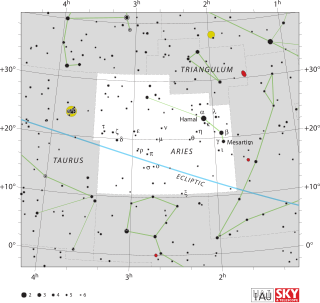
Aries is one of the constellations of the zodiac. It is located in the northern celestial hemisphere between Pisces to the west and Taurus to the east. The name Aries is Latin for ram, and its symbol is , representing a ram's horns. It is one of the 48 constellations described by the 2nd century astronomer Ptolemy, and remains one of the 88 modern constellations. It is a mid-sized constellation, ranking 39th overall size, with an area of 441 square degrees.

Ara is a southern constellation situated between Scorpius and Triangulum Australe. Ara was one of the 48 Greek constellations described by the 2nd century astronomer Ptolemy, and it remains one of the 88 modern constellations defined by the International Astronomical Union.

Boötes is a constellation in the northern sky, located between 0° and +60° declination, and 13 and 16 hours of right ascension on the celestial sphere. The name comes from the Greek Βοώτης, Boōtēs, meaning “herdsman” or “plowman”.
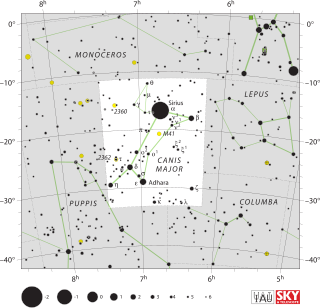
Canis Major is a constellation in the southern celestial hemisphere. In the second century, it was included in Ptolemy's 48 constellations, and is counted among the 88 modern constellations. Its name is Latin for "greater dog" in contrast to Canis Minor, the "lesser dog"; both figures are commonly represented as following the constellation of Orion the hunter through the sky. The Milky Way passes through Canis Major and several open clusters lie within its borders, most notably M41.

Canis Minor is a small constellation in the northern celestial hemisphere. In the second century, it was included as an asterism, or pattern, of two stars in Ptolemy's 48 constellations, and it is counted among the 88 modern constellations. Its name is Latin for "lesser dog", in contrast to Canis Major, the "greater dog"; both figures are commonly represented as following the constellation of Orion the hunter.

Fornax is a constellation in the southern sky, partly ringed by the celestial river Eridanus. Its name is Latin for furnace. It was named by French astronomer Nicolas Louis de Lacaille in 1756. Fornax is one of the 88 modern constellations.

Triangulum is a small constellation in the northern sky. Its name is Latin for "triangle", derived from its three brightest stars, which form a long and narrow triangle. Known to the ancient Babylonians and Greeks, Triangulum was one of the 48 constellations listed by the 2nd century astronomer Ptolemy. The celestial cartographers Johann Bayer and John Flamsteed catalogued the constellation's stars, giving six of them Bayer designations.
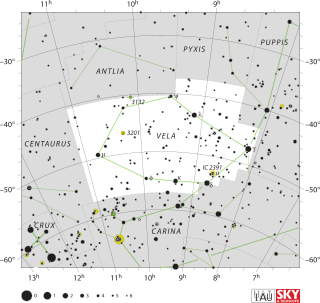
Vela is a constellation in the southern sky. Its name is Latin for the sails of a ship, and it was originally part of a larger constellation, the ship Argo Navis, which was later divided into three parts, the others being Carina and Puppis. With an apparent magnitude of 1.8, its brightest star is the hot blue multiple star Gamma Velorum, one component of which is the brightest Wolf-Rayet star in the sky. Delta and Kappa Velorum, together with Epsilon and Iota Carinae, form the asterism known as the False Cross. 1.95-magnitude Delta is actually a triple or quintuple star system.

Lynx is a constellation named after the animal, usually observed in the Northern Celestial Hemisphere. The constellation was introduced in the late 17th century by Johannes Hevelius. It is a faint constellation, with its brightest stars forming a zigzag line. The orange giant Alpha Lyncis is the brightest star in the constellation, and the semiregular variable star Y Lyncis is a target for amateur astronomers. Six star systems have been found to contain planets. Those of 6 Lyncis and HD 75898 were discovered by the Doppler method; those of XO-2, XO-4, XO-5 and WASP-13 were observed as they passed in front of the host star.

Cassiopeia is a constellation in the northern sky, named after the vain queen Cassiopeia in Greek mythology, who boasted about her unrivaled beauty. Cassiopeia was one of the 48 constellations listed by the 2nd-century Greek astronomer Ptolemy, and it remains one of the 88 modern constellations today. It is easily recognizable due to its distinctive 'W' shape, formed by five bright stars. It is opposite Ursa Major. In northern locations above latitude 34ºN it is visible year-round and in the (sub)tropics it can be seen at its clearest from September to early November. Even in low southern latitudes below 25ºS it can be seen low in the North.
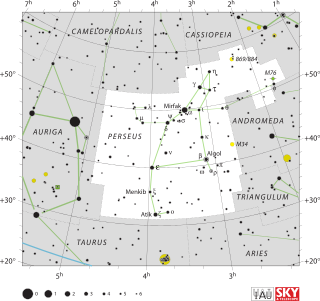
Perseus is a constellation in the northern sky, being named after the Greek mythological hero Perseus. It is one of the 48 ancient constellations listed by the 2nd-century astronomer Ptolemy, and among the 88 modern constellations defined by the International Astronomical Union (IAU). It is located near several other constellations named after ancient Greek legends surrounding Perseus, including Andromeda to the west and Cassiopeia to the north. Perseus is also bordered by Aries and Taurus to the south, Auriga to the east, Camelopardalis to the north, and Triangulum to the west. Some star atlases during the early 19th century also depicted Perseus holding the disembodied head of Medusa, whose asterism was named together as Perseus et Caput Medusae; however, this never came into popular usage.

Circinus is a small, faint constellation in the southern sky, first defined in 1756 by the French astronomer Nicolas-Louis de Lacaille. Its name is Latin for compass, referring to the drafting tool used for drawing circles. Its brightest star is Alpha Circini, with an apparent magnitude of 3.19. Slightly variable, it is the brightest rapidly oscillating Ap star in the night sky. AX Circini is a Cepheid variable visible with the unaided eye, and BX Circini is a faint star thought to have been formed from the merger of two white dwarfs. Two sun-like stars have planetary systems: HD 134060 has two small planets, and HD 129445 has a Jupiter-like planet. Supernova SN 185 appeared in Circinus in 185 AD and was recorded by Chinese observers. Two novae have been observed more recently, in the 20th century.

Corvus is a small constellation in the Southern Celestial Hemisphere. Its name means "raven" in Latin. One of the 48 constellations listed by the 2nd-century astronomer Ptolemy, it depicts a raven, a bird associated with stories about the god Apollo, perched on the back of Hydra the water snake. The four brightest stars, Gamma, Delta, Epsilon, and Beta Corvi, form a distinctive quadrilateral in the night sky.

The Antennae Galaxies, also known as NGC 4038/NGC 4039, are a pair of interacting galaxies in the constellation Corvus. They are currently going through a starburst phase, in which the collision of clouds of gas and dust, with entangled magnetic fields, causes rapid star formation. They were discovered by William Herschel in 1785.

NGC 7027 is a very young and dense planetary nebula located around 3,000 light-years from Earth in the constellation Cygnus. Discovered in 1878 by Édouard Stephan using the 800 mm (31 in) reflector at Marseille Observatory, it is one of the smallest planetary nebulae and by far the most extensively studied. Helium hydride was detected in the nebula in 2019, the first discovery of that molecule in space.

Gemini is one of the constellations of the zodiac. It was one of the 48 constellations described by the 2nd century AD astronomer Ptolemy, and it remains one of the 88 modern constellations today. Its name is Latin for "twins," and it is associated with the twins Castor and Pollux in Greek mythology. Its symbol is .
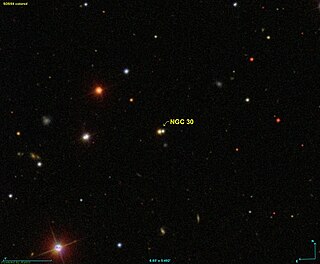
NGC 30 is a double star system in Pegasus constellation. It was recorded only once by German astronomer Albert Marth on October 30, 1864.
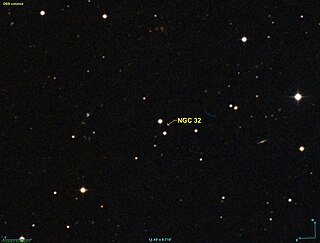
NGC 32 is a pair of G7 yellow dwarf stars in the constellation Pegasus. Although at a similar distance, the stars are physically unrelated. The dimmer, southern star is 2501±92 light-years from the Sun, while the brighter, northern star is 2927±88 light-years from the Sun.
NGC 44 is a binary star system located in the Andromeda constellation. It was first recorded by John Herschel on November 22, 1827. He noted "not to be seen but in the clearest night" and that it was "extremely faint, very small". Although the stars appear to be at a similar distance, their motion is extremely different from each other. The eastern star is approximately 3430±200 light-years away, while the western star is approximately 3440±210 light-years away. While the distances seem similar, the error bars mean the stars could just as easily be 3230 and 3650 light-years from the Sun, or 3630 and 3230 light-years from the Sun.

NGC 513, also occasionally referred to as PGC 5174 or UGC 953, is a spiral galaxy in the constellation Andromeda. It is located approximately 262 million light-years from the Solar System and was discovered on 13 September 1784 by astronomer William Herschel.






















